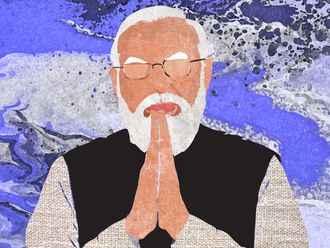This is the time to return to Jalesveva Jayamahe (in the ocean we will triumph). For too long, we have neglected the seas, oceans, straits and bays ... We must possess the soul of Cakrawarti Samudra (emperor of the sea),” Joko Widodo, the newly sworn-in president of Indonesia said in his inaugural address last month, outlining his vision of turning the archipelagic nation the world’s “maritime axis”.
Joko’s sea-centric speech placed his country instantly in the same wavelength as the US rebalancing, China’s Silk Road initiative and India’s Act East policy, as he has also sought greater engagement with multilateral maritime groupings like the Indian Ocean Rim Association (IORA) that Indonesia is likely to lead at the end of 2015. During the election campaign, Widodo and his running mate Jusuf Kalla had released Visi Misi (Vision Mission) — a policy platform that indicated expanding engagement in Indo-Pacific, viewing the region as a single geopolitical and strategic entity. Also, it articulated the concept of “dynamic equilibrium” that envisioned cooperation with major powers for inclusive regional development and, as some analysts say, the development of a counterweight to China’s assertiveness in the South China Sea.
Retno Marsudi, the new Foreign Minister of Indonesia, has now said that her office would focus on realising the president’s vision in the next five years.
And Widodo himself is expected to talk about his vision this month in multilateral fora like the Asean (Association of Sout-East Asian Nations) Summit and the 9th East Asia Summit (EAS) in the Myanmarese capital of Naypyidaw, where Indian Prime Minister Narendra Modi will have an opportunity to interact with him.
Both leaders have a few things in common. They have worked their way up to national politics from underprivileged backgrounds and provinces. If one calls himself a “chaiwallah” (tea seller), then the other is a “furniturewallah” (maker of furniture), who jokes that his face looks like that of a street food vendor. More importantly, their views on governance and policy-making, particularly emphasis on economic diplomacy, fixing the domestic infrastructure and harnessing demographic dividends, are quite similar, although their approaches may vary.
Modi had in a message wished Widodo success and pledged India’s partnership in realising his goals. It will be interesting to watch how the two leaders vibe, as Widodo recently said: “The most important thing is meeting leaders face to face and develop those relationships.” But more than the personal meeting, it is the convergence of strategic interest that will bind the two neighbours. A spread-out archipelago of 13,500 islands, Indonesia is less than 100 nautical miles from India’s Nicobar Islands and sits astride the world’s busiest shipping lane in the Strait of Malacca, where both seek to ensure freedom of navigation and safeguard maritime security.
Widodo’s strategic plan to place Indonesia as the global maritime axis is expected to promote connectivity between the Indian Ocean and the Pacific and thereby ensure stability in the region. Leonard C. Sebastian and Emiraza Adi Sayilendra of the Nanyang Techonological University say Widodo’s idea follows the strategy adopted by the seventh century Srivijaya kingdom, when all trade between West and East Asia passed through the sea ports that were dominated by Srivijaya. The kingdom’s ability to protect the sea lanes from pirates legitimised its position as the maritime axis of the world.
Now Indonesia seeks to secure important choke points in the Indian Ocean such as Malacca, Sunda and Lambok Straits. Joko’s vision and Indonesia’s earlier proposal for an Indo-Pacific “Treaty of Friendship and Cooperation” supposes cooperation with countries like India on transnational security challenges.
This jells well with India’s own maritime security policy. Ninety per cent of world trade flows by sea and a majority of that through the vulnerable straits of Malacca, Singapore and Taiwan. India’s dependence on the sea for import of energy resources, critical to economic growth, and its growing trade force it to play a more effective role in the region. India is looking to the South China Sea as a source of energy. It signed an agreement with Vietnam last month to prospect new fields, besides exploring the two blocks off the Vietnam coast. India also extended a $100 million (Dh367.8 million) credit line to Hanoi to buy offshore patrol vehicles and is helping the country build its defence capabilities.
The Modi government has effected a substantive shift in India’s approach to the region in turning the “Look East” to an “Act East” policy. Modi amplified this during Vietnamese Prime Minister Nguyen Tan Dung’s October 27-28 visit, saying India has “shared interest in maritime security, including freedom of navigational commerce and peaceful settlement of maritime disputes in accordance with international law.”
And that is why, he said, his government has “purposefully intensified engagement in the Asia-Pacific region”. A major policy plank of the Modi government is integrating the subcontinent with the markets of Southeast and East Asia. India and Indonesia share a strategic partnership inked in 2007. During former Indian prime minister Manmohan Singh’s summit meeting with the then Indonesia president Susilo Bambang Yudhoyono last year, the two countries agreed to adopt a five-pronged initiative that included defence and security cooperation and cooperation in responding to common challenges. A year later, that looks a tall order. Rizal Sukma, director of Jakarta’s Centre for Strategic and International Studies, who worked within Widodo’s transition team, says: “The relationship has not reached half its potential.”
And this is something for Modi to think about, as the high-stakes game hots up in the Indo-Pacific.
— IANS
Saroj Mohanty is a veteran journalist and analyst.











